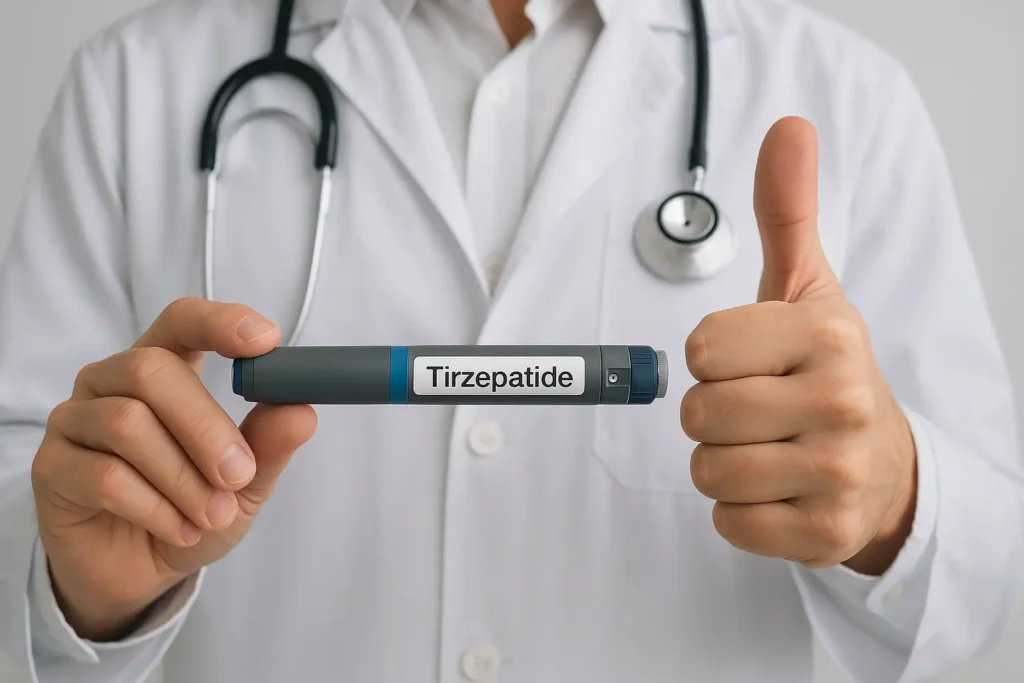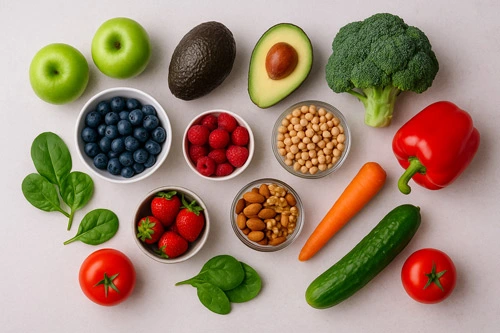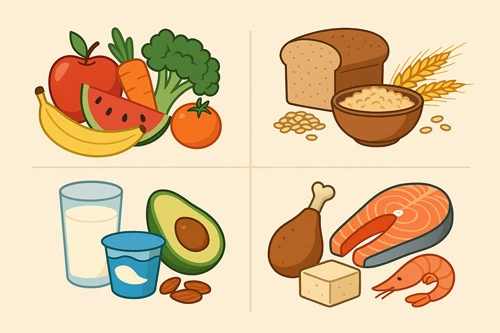Introduction:
The Galveston Diet is more than just a weight loss plan—it’s a comprehensive, science-backed wellness strategy designed specifically for women navigating menopause and perimenopause. Touted as “Your Ultimate Menopause Health Plan,” this unique approach integrates elements of anti-inflammatory nutrition, intermittent fasting, and macronutrient balancing to target the real root causes of midlife weight gain: hormonal shifts and chronic inflammation.
In recent years, interest in the Galveston Diet has exploded, with thousands searching for resources like the Galveston Diet book, PDF meal plans, and 1-week beginner meal plans to kickstart their journey. The diet’s rising popularity can also be seen through platforms such as Reddit, where real women share their honest Galveston Diet reviews, discuss recipes, and debate the effectiveness of its macros-based strategy. Many are also turning to downloadable resources like the Galveston Diet meal plan PDF and the highly sought-after Galveston Diet bonus PDF free download to support their daily routines.
Created by OB-GYN Dr. Mary Claire Haver and named after Galveston, Texas, this method is tailored to women who feel that traditional diets fail to address the unique metabolic challenges of menopause. With structured guidance, delicious Galveston Diet recipes, and the enhanced program option for deeper support, it’s no wonder why this lifestyle plan has become a cornerstone for women’s midlife wellness.
In this in-depth guide, we’ll walk you through the Galveston Diet meal plan, explore real reviews, unpack the science behind its macros, and answer the question: Why is it called the Galveston Diet? Whether you’re curious about the book, searching for a summary, or ready to dive into the enhanced program, this article is your complete roadmap.
What Is the Galveston Diet and Why Is It Called That?
The Galveston Diet is a pioneering nutrition and lifestyle program created by Dr. Mary Claire Haver, a board-certified OB-GYN who saw firsthand how conventional diet plans were failing her midlife patients—especially women going through perimenopause and menopause. Designed to combat hormonal weight gain, chronic inflammation, and metabolic slowdown, the Galveston Diet offers an integrative solution for women who feel stuck despite “eating right” and “exercising more.”
At its core, the diet follows three main pillars:
-
Anti-inflammatory nutrition
-
Intermittent fasting
-
Balanced macronutrients (macros)
These components work synergistically to optimize hormone health, reduce bloating, support fat metabolism, and promote overall well-being. Unlike many generic programs, The Galveston Diet: Your Ultimate Menopause Health Plan targets the biological changes that uniquely affect women in midlife, making it a more personalized and sustainable approach.
So, why is it called the Galveston Diet? The name comes from Galveston, Texas, where Dr. Haver lives and practiced medicine. It’s both a nod to her roots and a symbol of her mission to help women across the country find relief, energy, and confidence during what can otherwise be a frustrating phase of life.
As highlighted in the Galveston Diet summary, this is not a one-size-fits-all weight loss gimmick. It’s a lifestyle plan rooted in medical insight, tailored for hormonal harmony, and supported by thousands of women who have embraced the Galveston Diet enhanced program to transform their health from the inside out.
learn more: Optavia Diet Explained: Plan, Cost & Feedback
Core Principles of the Galveston Diet
The Galveston Diet is not just another trendy weight-loss program—it’s a science-based framework built on three essential pillars that directly address the biological challenges faced by women in perimenopause and menopause. These core principles form the foundation of the Galveston Diet and are central to the effectiveness of both the standard and the enhanced program.
🟠 1. Anti-Inflammatory Nutrition
One of the key drivers of midlife weight gain and fatigue is chronic inflammation. The Galveston Diet emphasizes anti-inflammatory foods such as leafy greens, berries, fatty fish, nuts, olive oil, and low-glycemic vegetables. By reducing inflammation, the body becomes more efficient in burning fat and regulating hormones, which is especially important during menopause.
This focus on inflammation-fighting ingredients also helps manage conditions like insulin resistance, joint pain, and brain fog—all of which are commonly reported by women in this stage of life.
🔵 2. Intermittent Fasting (IF)
Intermittent fasting is another cornerstone of the Galveston Diet. Instead of focusing solely on what you eat, this principle focuses on when you eat. A common fasting window used in the program is 16:8—meaning 16 hours of fasting followed by an 8-hour eating period.
This pattern of eating promotes autophagy (cellular cleansing), stabilizes blood sugar, supports fat metabolism, and helps regulate hormones like insulin and cortisol. Fasting has also been linked to improved mental clarity and energy levels.
🟢 3. Balanced Macronutrients (Macros)
The Galveston Diet uses a macros-based approach to ensure women are getting the right balance of fat, protein, and carbohydrates—especially healthy fats and lean proteins. Unlike many low-fat diets that can actually worsen hormonal imbalances, the Galveston Diet encourages higher healthy fat intake, moderate protein, and controlled carbohydrates.
This focus on macronutrient ratios—often referred to as the Galveston Diet macros—helps women fuel their bodies properly, stabilize energy, and burn fat more efficiently.
The combination of these three principles sets the Galveston Diet apart from conventional plans. And for those looking for deeper support and structured guidance, the Galveston Diet Enhanced Program offers educational videos, live coaching, detailed recipes, and community support to ensure long-term success.
Together, these principles form a flexible, empowering roadmap for women who are tired of fighting their bodies and are ready to work with their biology—not against it.
learn more: Mediterranean Diet: A Complete Guide to Principles, Meal Plans, Recipes
The Galveston Diet Meal Plan Overview
Unlike rigid or restrictive diet plans, the Galveston Diet meal plan offers a flexible framework that empowers women to eat in a way that supports their hormones, metabolism, and energy levels. The core idea is to fuel your body with whole, anti-inflammatory foods while following an intermittent fasting schedule and a balanced macronutrient profile.
This section outlines how a typical Galveston Diet meal plan is structured—especially for those just starting out.
🗓 1-Week Beginner Galveston Diet Meal Plan
If you’re new to the diet, a 1-week beginner Galveston Diet meal plan is a great way to ease into the routine without feeling overwhelmed. Here’s a general idea of what a sample day might look like:
⏰ Intermittent Fasting Window
-
Fasting: 8:00 PM – 12:00 PM
-
Eating Window: 12:00 PM – 8:00 PM
🍽 Sample Daily Meal Structure
Meal 1 (Lunch – 12:00 PM):
-
Grilled salmon with spinach and avocado
-
Olive oil vinaigrette
-
Small handful of almonds
Snack (3:00 PM):
-
Hard-boiled egg
-
Sliced cucumber with hummus
Meal 2 (Dinner – 7:00 PM):
-
Zucchini noodles with ground turkey and pesto
-
Roasted Brussels sprouts with garlic
Hydration:
-
Infused water, green tea, black coffee (during fasting)
This basic outline helps you stay within your macro targets while embracing foods that fight inflammation and support hormone balance.
📄 Galveston Diet Meal Plan PDF
Many women prefer to follow a printed or downloadable version of the plan, which is why the Galveston Diet meal plan PDF has become incredibly popular. These PDF guides usually include:
-
Daily meal ideas
-
Shopping lists
-
Portion control tips
-
Weekly check-ins
You can find both free and paid versions of the Galveston Diet PDF meal plans, including those that come with the bonus resources or the enhanced program.
Whether you prefer to follow a structured guide or mix and match meals using Galveston-friendly ingredients, this diet offers the flexibility and clarity needed to build habits that last—without the overwhelm or confusion of more traditional diets.
Sample Recipes for the Galveston Diet
One of the best parts of following the Galveston Diet is that it doesn’t feel like a typical “diet”—you get to enjoy flavorful, satisfying meals that work with your body instead of against it. If you’re wondering what kind of food you can eat on this plan, these Galveston Diet recipes are a great place to start. Each one follows the diet’s core principles: high in healthy fats, moderate in protein, low in processed carbs, and packed with anti-inflammatory ingredients.
🥑 1. Avocado Egg Bowl (Brunch or Lunch Option)
Ingredients:
-
1 ripe avocado
-
2 boiled eggs
-
1 tbsp olive oil
-
Dash of sea salt & black pepper
-
Sliced cherry tomatoes
-
Optional: sprinkle of chili flakes or hemp seeds
Instructions:
-
Cut the avocado in half, remove the seed, and scoop into a bowl.
-
Chop boiled eggs and mix with avocado.
-
Add olive oil, salt, pepper, and toppings.
-
Serve fresh—delicious and loaded with healthy fats and protein.
✅ Anti-inflammatory | ✅ High-fat | ✅ Low-carb
🐟 2. Lemon Herb Salmon with Sautéed Greens (Dinner)
Ingredients:
-
1 salmon filet
-
1 tbsp coconut oil or olive oil
-
Juice of ½ lemon
-
Garlic powder, dill, salt, pepper
-
1 cup spinach + 1 cup kale
Instructions:
-
Rub salmon with garlic, dill, lemon juice, and seasoning.
-
Pan-fry or bake at 400°F (200°C) for 12–15 minutes.
-
In a separate pan, sauté greens in coconut oil until wilted.
-
Serve hot with lemon wedges.
✅ High in omega-3s | ✅ Hormone-supportive | ✅ Easy & fast
🥗 3. Chickpea Avocado Salad (Snack or Light Meal)
Ingredients:
-
½ cup canned chickpeas (rinsed & drained)
-
½ avocado, cubed
-
Diced cucumber
-
Squeeze of lemon juice
-
1 tbsp extra virgin olive oil
-
Pinch of cumin, sea salt, and parsley
Instructions:
-
Mix all ingredients in a medium bowl.
-
Toss until well combined.
-
Let chill for 10 minutes before serving for best flavor.
✅ Plant-based protein | ✅ Fiber-rich | ✅ Anti-inflammatory
These Galveston Diet recipes are easy to prepare, nutritionally balanced, and perfect for your intermittent fasting eating window. Whether you’re new to the plan or a seasoned follower, they provide variety without compromising your goals.
👉 For more ideas, many women download the Galveston Diet meal plan PDF or explore the recipes section included in The Galveston Diet book or enhanced program.
learn more: Hashimoto Diet: Your Essential Guide to Thyroid Health
The Galveston Diet Book and Bonus PDF Resources
If you’re looking to dive deeper into the science, structure, and day-to-day practices of this powerful program, The Galveston Diet book is your go-to guide. Written by the creator of the diet, Dr. Mary Claire Haver, the book serves as a comprehensive blueprint for women seeking sustainable weight loss, hormonal balance, and inflammation reduction during menopause and beyond.
📘 What’s Inside The Galveston Diet Book?
The book is far more than a basic meal plan—it’s a full educational resource that covers:
-
The biological reasons why midlife women gain weight
-
The role of estrogen, insulin, and cortisol in fat storage
-
The benefits of intermittent fasting
-
How to use macronutrients (fats, proteins, carbs) to your advantage
-
Anti-inflammatory eating patterns and food lists
-
Emotional triggers and mindset shifts needed for long-term success
-
Easy-to-follow Galveston Diet recipes
-
Sample weekly meal plans and tracking tools
Whether you’re a beginner or have already tried other diet programs, the Galveston Diet book is an excellent way to understand not only what to eat, but why it works.
📄 The Galveston Diet PDF: Convenience in Your Hands
For many women, having a digital version of the content is essential. That’s why The Galveston Diet PDF is a popular format—it offers the flexibility to carry the meal plan, food lists, and recipe guides anywhere on your phone, tablet, or computer. Many PDFs also come with:
-
Printable meal tracking sheets
-
Grocery shopping lists
-
Daily fasting schedule guides
-
Macronutrient cheat sheets
-
Sample 1-week and 4-week meal plans
Some versions of the PDF are included when you purchase the enhanced program or sign up for the official course. However, free versions may also be available through community forums or promotional offers.
🎁 The Galveston Diet Bonus PDF Free Download
In addition to the core program, many users search for the Galveston Diet bonus PDF free download, which may include:
-
Advanced meal prep tips
-
Extra recipes and snack ideas
-
Supplement recommendations
-
Hormone balance checklists
-
Goal-setting worksheets
Please note that official bonus PDFs are typically offered as part of Dr. Haver’s paid programs, and accessing them through unauthorized sources is discouraged. If you’re serious about getting the most out of the Galveston Diet, it’s best to use official materials for accuracy and effectiveness.
Between the depth of the Galveston Diet book, the practicality of the PDF resources, and the convenience of printable tools and meal plans, it’s clear that this program is designed to set women up for long-term success—not just a temporary fix.
Side Effects and Risks of the Calorie Deficit Diet
While a calorie deficit is essential for weight loss, it can come with several potential side effects—especially if the deficit is too large or sustained for too long. Here are some of the common risks and side effects associated with a calorie deficit diet:
-
Fatigue and Low Energy
Consuming fewer calories than your body needs may lead to persistent tiredness and a lack of energy. This happens because your body doesn’t get enough fuel to perform daily tasks effectively. -
Nutrient Deficiencies
Severe calorie restriction often leads to insufficient intake of essential vitamins and minerals such as iron, vitamin D, B12, calcium, and magnesium. Over time, this can cause anemia, weakened bones, and poor immune function. -
Slowed Metabolism
A long-term calorie deficit can signal your body to conserve energy by slowing your metabolic rate. This can make future weight loss harder and might even result in weight gain once normal eating resumes. -
Muscle Loss
Without enough protein and calories, your body may start breaking down muscle tissue for energy, leading to decreased strength, poor body composition, and lower resting metabolic rate. -
Hormonal Imbalances
Especially in women, extreme calorie deficits can disrupt hormonal balance, leading to menstrual irregularities, fertility issues, or thyroid dysfunction. -
Mood Changes and Irritability
Low energy intake can negatively impact neurotransmitters in the brain, contributing to irritability, anxiety, or even depression. -
Disordered Eating Patterns
Chronic dieting and calorie restriction can increase the risk of developing unhealthy relationships with food, such as binge eating, obsessive calorie tracking, or eating disorders like orthorexia or anorexia. -
Poor Workout Performance
A lack of sufficient calories may reduce exercise performance, endurance, and recovery ability, making workouts less effective.
How to Follow a Calorie Deficit Diet Safely and Effectively
Achieving weight loss through a calorie deficit doesn’t mean you have to suffer from low energy, nutrient deficiencies, or other side effects. By following some key guidelines, you can create a safe and sustainable calorie deficit that supports your health and goals.
1. Calculate Your Individual Calorie Needs
Start by estimating your Total Daily Energy Expenditure (TDEE), which accounts for your age, sex, weight, height, and activity level. Aim for a moderate deficit—usually around 10-20% below your maintenance calories—to encourage steady weight loss without compromising your metabolism.
2. Prioritize Nutrient-Dense Foods
Focus on whole foods rich in vitamins, minerals, fiber, and protein. Include plenty of vegetables, fruits, lean proteins, whole grains, and healthy fats. This helps prevent nutrient deficiencies and keeps you fuller longer.
3. Ensure Adequate Protein Intake
Protein is crucial for preserving muscle mass during weight loss. Aim for about 1.2–2.0 grams of protein per kilogram of body weight daily, depending on your activity level.
4. Incorporate Strength Training
Exercise, especially resistance training, signals your body to maintain muscle tissue and boosts metabolism. Pair your calorie deficit with regular workouts for best results.
5. Stay Hydrated and Get Enough Sleep
Water supports metabolism and appetite regulation, while sleep is essential for hormone balance and recovery. Aim for 7–9 hours of quality sleep per night.
6. Avoid Extreme Restrictions and Listen to Your Body
Don’t reduce calories drastically or skip meals. Pay attention to hunger cues and energy levels. Adjust your plan if you feel fatigued or unwell.
Following these guidelines will help you lose weight effectively while minimizing the risk of side effects. Remember, a calorie deficit diet is a tool—not a punishment—and your overall well-being should always come first.
Sample Calorie Deficit Meal Plan for a Day
Creating a meal plan that fits your calorie goals while keeping you satisfied and nourished is key to success. Below is a simple example of a balanced calorie deficit day:
Breakfast:
-
Greek yogurt (150g) with fresh berries and a sprinkle of chia seeds
-
Black coffee or herbal tea
Snack:
-
A small handful of almonds (about 15 nuts)
Lunch:
-
Grilled chicken breast (120g)
-
Quinoa salad with cucumbers, tomatoes, parsley, and olive oil
-
Steamed broccoli
Snack:
-
Carrot sticks with hummus (2 tablespoons)
Dinner:
-
Baked salmon (150g) with lemon and herbs
-
Roasted sweet potatoes (100g)
-
Mixed green salad with balsamic vinaigrette
Hydration:
-
Plenty of water throughout the day
Tips for Maintaining Your Calorie Deficit
-
Track Your Intake: Use apps like MyFitnessPal to keep an eye on calories and macros.
-
Plan Meals Ahead: Preparing meals in advance prevents impulsive eating.
-
Be Flexible: Allow occasional treats to avoid feelings of deprivation.
-
Listen to Hunger: Eat when hungry and stop when satisfied, not overly full.
-
Adjust as Needed: Monitor progress and adjust calories or activity levels accordingly.
Day 2
Breakfast:
-
Smoothie with spinach, protein powder, frozen berries, and unsweetened almond milk
Snack:
-
Hard-boiled egg
Lunch:
-
Baked salmon (150g)
-
Quinoa salad with kale, walnuts, cranberries, and vinaigrette
Snack:
-
Carrot sticks with guacamole (2 tbsp)
Dinner:
-
Lean beef stir-fry with mixed vegetables (snap peas, mushrooms, zucchini)
-
Small serving of whole wheat noodles
Day 3
Breakfast:
-
Greek yogurt (150g) with flaxseeds and fresh strawberries
Snack:
-
Handful of mixed nuts (about 15)
Lunch:
-
Chicken and vegetable soup
-
Side salad with olive oil dressing
Snack:
-
Celery sticks with natural peanut butter (1 tbsp)
Dinner:
-
Grilled shrimp (150g)
-
Steamed asparagus
-
Sweet potato mash (100g)
Tips to Maximize Results
-
Drink water before meals to aid fullness.
-
Keep portion sizes consistent.
-
Adjust snacks or meals slightly if you feel too hungry or too full.
-
Pair diet with regular exercise to maintain muscle and boost metabolism.
learn more: Optavia Diet Explained: Plan, Cost & Feedback
Common Mistakes to Avoid on a Calorie Deficit Diet
While creating a calorie deficit is fundamental for weight loss, many people unknowingly sabotage their progress by making some common errors. Avoiding these pitfalls can help you stay on track and achieve sustainable results.
1. Cutting Calories Too Drastically
Severe calorie restriction can backfire by slowing metabolism, causing muscle loss, and increasing hunger and cravings. Aim for a moderate deficit instead.
2. Neglecting Protein Intake
Protein is essential for preserving muscle mass during weight loss and keeping you full. Not eating enough protein can lead to muscle wasting and increased hunger.
3. Ignoring Nutrient Quality
Focusing only on calorie counting without considering nutrient-dense foods can result in vitamin and mineral deficiencies.
4. Skipping Meals or Relying on Fad Diets
Skipping meals can lead to overeating later, while fad diets often lack balance and sustainability.
5. Not Tracking Progress Properly
Failing to monitor weight, measurements, and how you feel can make it difficult to adjust your plan effectively.
6. Overlooking Hydration and Sleep
Both water intake and quality sleep are critical for metabolism and appetite regulation.
7. Relying Solely on the Scale
Weight fluctuates daily; focus also on body composition, energy levels, and overall well-being.
Avoiding these mistakes will make your calorie deficit journey healthier and more effective. Remember, consistency and balanced nutrition are key.
Exercise Tips to Complement a Calorie Deficit Diet
Incorporating exercise into your calorie deficit plan can accelerate fat loss, preserve muscle mass, and boost overall health. Here are some tips to get the most out of your workouts while dieting:
1. Prioritize Strength Training
Resistance exercises like weightlifting or bodyweight workouts help maintain and build muscle during calorie restriction. This supports a healthy metabolism and improves body composition.
2. Include Cardiovascular Exercise
Moderate cardio activities such as walking, cycling, or swimming increase calorie burn and improve heart health. Aim for at least 150 minutes of moderate-intensity cardio per week.
3. Don’t Overtrain
Excessive exercise without proper nutrition and rest can lead to fatigue, injury, and stalled progress. Balance activity with recovery days.
4. Incorporate Flexibility and Mobility Work
Yoga, stretching, and mobility drills improve movement quality, reduce injury risk, and support long-term fitness.
5. Listen to Your Body
Adjust workout intensity based on energy levels, especially during a calorie deficit, to avoid burnout.
6. Stay Consistent
Regular exercise, combined with a proper calorie deficit, is the most reliable way to achieve sustainable weight loss and improved health.
Conclusion: Is the Calorie Deficit Diet Right for You?
The calorie deficit diet remains one of the most effective and scientifically proven methods for weight loss. When done correctly, it helps reduce body fat, improve metabolic health, and enhance overall well-being. However, as we discussed, it is crucial to avoid extreme calorie cuts and to focus on balanced nutrition, adequate protein intake, and regular exercise to maintain muscle mass and prevent common side effects.
By understanding your individual calorie needs, prioritizing nutrient-dense foods, and pairing your diet with strength and cardio training, you can create a sustainable lifestyle that supports your health goals long-term.
Remember, successful weight loss is not about quick fixes or drastic measures—it’s about consistent, informed choices that respect your body’s unique needs.
If you approach the calorie deficit diet with care and patience, it can be a powerful tool to help you reach your goals while maintaining energy, vitality, and a positive relationship with food.






